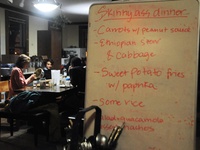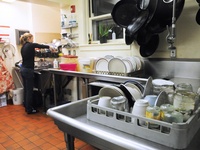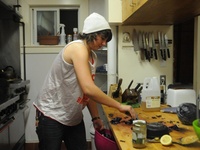AT THE TABLE
By 6:45 p.m., over 20 Co-op residents were seated at the long central table among an assortment of old mugs and mismatched plates and chairs, a stark contrast to the uniformity of House dining halls.
The Co-op dining hall is the central space of the building, and it brings the community together throughout the day, according to Iman E. James ’12.
“I’ve been sitting at this dining table for the past six hours. The dining room is actually more social than the living room, not even including dinners,” James said.
Quiet conversations and the clinking of forks filled the room. As Goldfeder took her plate at the table, everyone looked up from their food and began to clap—a nightly tradition of thanking the cook.
“I love dinner and the whole ritual of sitting down,” Eva B. Rosenberg ’10 said. “Everyone is there at more or less the same time, and there’s always fun conversations and bonding. It’s the best way to show a non-Co-oper what it’s about.”
Some residents, however, acknowledge the drawbacks of not having the House dining hall experience or a Harvard meal plan.
“Harvard has no central space, so the dining hall serves that purpose. Technically, we’re kind of excluded,” Forbes said. “I miss the free French fries.”
After ten minutes, the table fell silent as Forbes began the Co-op’s weekly meeting, held over dinner each Sunday. This evening, the students discussed the idea of reducing communal dinners to give people a break from cooking during the stress of exams.
After debate on the proposal, Anne Marie Zapf-Belanger ’10 made an earnest appeal to the other residents to keep cooking.
“I would like to have dinner during exams because dinner makes me happy,” she said.
A few snaps of agreement could be heard in the room as the Co-op residents voted to keep cooking dinner, another example of the “very, very close-knit” community Hogle described.
—Staff writer Stephanie B. Garlock can be reached at sgarlock@college.harvard.edu.











